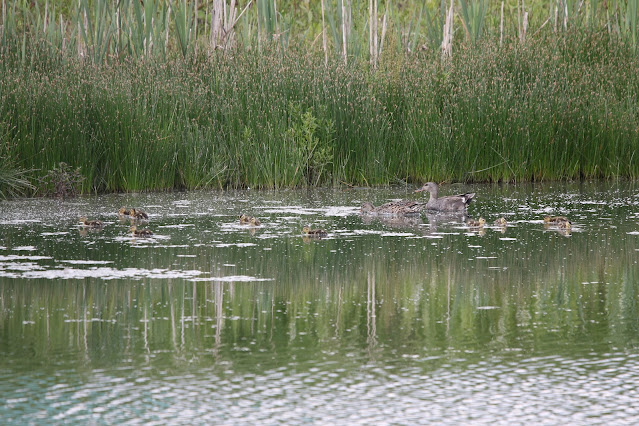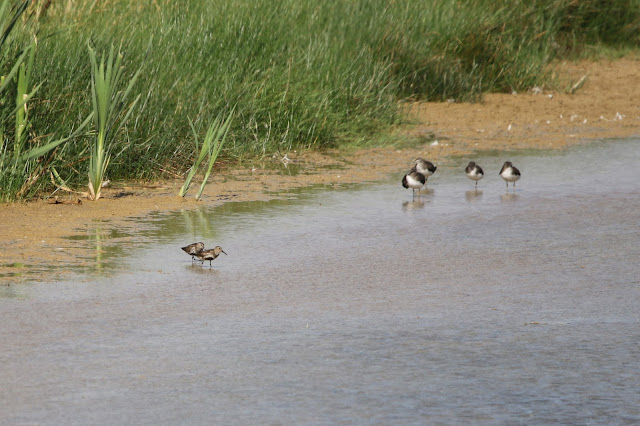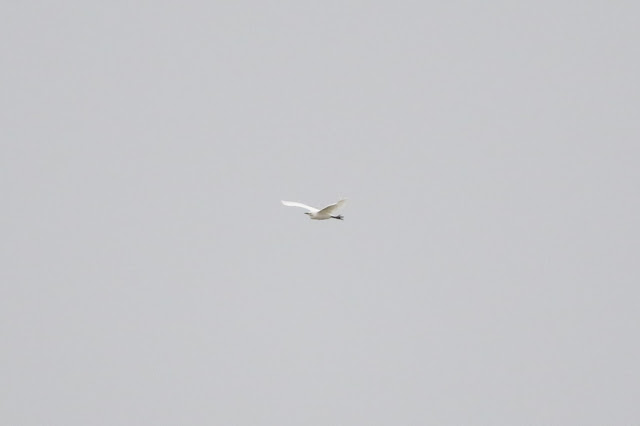Ardley ERF - Second half 2024
After a really good first half of the year on the Ardley patch, the hope for a good autumn on the wader-front well and truly materialised. After Redshank and Greenshank in June and July the goods kept on coming at regular intervals. It was pretty much one out one in as the passage period progressed. The water levels on the lagoon were ideal and continued that way through late summer into early autumn.
Common sandpipers were pretty regular from early July onwards, usually individuals but three together on 11th July was the most I've had here in one go.
Another species on the radar in July was Black-tailed godwit, and lo and behold JFT found a couple on 23rd. I headed over on the afternoon he found them expecting they wouldn't hang about but, I need not have worried as they stayed for a few days.
Green sandpiper numbers build in July and into August. Ardley is clearly an important site for them on migration and it's easy to get a bit blasé about them. I think 11 was the peak count this year on a few occasions before most move on. They often hop over into the working quarry area as well as being on the lagoon so not always easy to know how many there might be across the site. One or two usually winter here. Lapwing numbers also rose in mid-summer when at times there could be over 100 on the lagoon.
The first Ringed plover appeared on 9th August, the same day as two Dunlin. The turnover was regular and it felt like you couldn't afford to miss a day in case something went unseen. I think between JFT and me we pretty much visited every day in this peak period.
A second Ringed plover was present on 24th August in company with a juv Little ringed plover. It was a good year for Little ringed plovers. It seems a potential breeding site but the water levels on the lagoon are capricious and the quarry landscape is always changing so probably doesn't offer reliability to try and raise young.
The 10th August brought another much hoped for Ardley tick in the shape of a Wood Sandpiper. JFT found it in the evening which meant a quick dash over before the light faded to see the bird, a lovely juvenile. It departed overnight so I was lucky to see it. Too distant and dark for the camera, a bit of phonescoping had to suffice.
A relatively quiet few weeks followed with no stand out visitors. JFT and I have discussed birds that feel possible at Ardley, some of which have now appeared. We are still waiting for a Wryneck (which may be a long wait) but Little Stint has been on our wish list here. 2nd September was the first of two epic days at Farmoor and was clearly a day where a lot of good birds were turning up inland. The Ardley obsession meant it had to be checked for fear of missing something. On my walk down to the lagoon I saw a Common Redstart in the hedge line. It is a reliable spot for them over the past few years. I spent a while trying to get a decent view but could only get brief glimpses as I pushed it along the hedge row as I made my way down to the lagoon. A good bird for the year list, I messaged JFT to let him know. He asked if I'd looked at the lagoon yet, but I said not yet, to which he replied "Hopefully good news and there's a Little Stint!" And within 15 minutes I replied, "no joke, 2 Little Stints!" Fortunately he was on his way home from work so was not far away and joined me shortly afterwards. They were nicely positioned at the nearside of the lagoon so gave as good a view as we could have hoped for.
The water levels on the lagoon had been ideal. It was tempting to get greedy and expect something more, but those hopes were ended when the exceptionally wet weather hit towards the end of September and raised the water levels on the lagoon significantly. However, the variety and quality at Ardley this year was exceptional. 14 wader species across the year is good going for a site like this. Spotted Redshank and Curlew Sandpiper in recent years shows what the site is capable of when the conditions are right.
Clearly the focus was on waders during the autumn passage period but there were other good birds to see and add to the Patchwork Challenge list. Overshadowed by the Stints on 2nd September was a fly over Common Tern. My first tern at Ardley.
The hope for some gulls is always an additional draw for Ardley. Some were roosting for a while on the lagoon and in the quarry in late summer, but aside from Yellow-legged gulls, nothing of note. Large numbers of Black-headed gulls raised the hopes that a Med gull might be among their number, but that hoped for patch tick continues.
In October a patch tick came in the form of a Pochard. This drake was on the quarry lake and is added to the Red-crested pochard from earlier in the year and the Canvasback. Provenance of the Canvasback aside, bizarre to get all three of those at Ardley in the span of 5 months.
On the same day as the Pochard were two Little egrets. They are an uncommon bird at Ardley so two at once was a nice record and only the second and third I'd seen there this year. Thereafter, one remained fairly regular for the rest of the year around the quarry lake.
October and November saw an increase in the number of gulls loafing on the adjacent quarry. At times up to 1000 gulls were present, mainly Lesser Black-Backed, with smaller numbers of Yellow-legged gulls and herring gulls. Yellow-Legged often outnumber Herring.
 |
| Sub-adult Yellow-legged gull in the images above (centre bird in top photo). Four other YLGs in that photo as well. |
On 17th November I got a much anticipated patch tick in the form of Caspian gull. Not one, but two, albeit I only saw one of them! I was concentrating on the one on the ground and I didn't see the other one. I only realised there were two when I was at home later sorting through my photos. Easily done with large gatherings of gulls and a complete fluke I just happened to take photos of the first one as the second flew through the shot.
The first bird didn't appear to be a "classic" looking bird. The head shape, pale eye and slightly odd shaped bill had me questioning it a bit. But its primary pattern, pale head, some neck streaking, long-wings, and plain grey upperparts confirmed it was. The inadvertent photos of the second bird suggest that one was probably a more typical-looking individual judging from the bill, head shape and seemingly darker eye.
 |
| The first Casp above. |
 |
| The second bird. |
On 3rd November a fly-over Cattle Egret was a nice addition to the year list and only my second at Ardley. The bird appeared dark billed which would suggest a juvenile bird. There were still young birds at Blenheim at the beginning of October so may well have been one of those given I wouldn't expect most 1st year birds to still have a dark bill at this time of year. The dark bill is lost quite quickly from the literature I've read so presumably this one was still a pretty young bird.
Other highlights included at least 22 cormorants on the small quarry lake on 15th November. It clearly must have a lot of fish in it. As it often the case cormorants are very skittish so most of them took to the sky for a fly around on seeing me.
Overall, a great year and a good number of patch ticks. Most satisfying were the really enjoyable moments finding and twitching some of the scarce birds that appeared during the year.
100 species for the year was more than I expected. In terms of misses, Coal tit, Raven and Barn Owl were half expected at some point during the year but I didn't manage them.
A few other photos from the second half of the year...
 |
| Gadwall family |
 |
| Presumed Barnacle x Canada hybrid. |
 |
| The only Hobby I saw at Ardley this year |
 |
| Grey Partridges on the lagoon, unusually. |










































Comments
Post a Comment